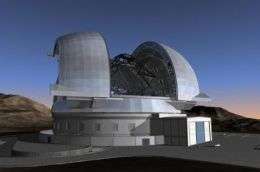Europe unveils 20-year plan for brilliant future in astronomy

Europe is a leader in astronomy today, with the world's most successful optical observatory, ESO's Very Large Telescope, and cutting-edge facilities in radio astronomy and in space. In an unprecedented effort demonstrating the potential of European scientific cooperation, all of European astronomy is now joining forces to define the scientific challenges for the future and construct a common plan to address them in a cost-effective manner.
In 2007, a top-level Science Vision was prepared to assess the most burning scientific questions over the next quarter century, ranging from dark energy to life on other planets. European astronomy now presents its Infrastructure Roadmap, a comprehensive 20-year plan to coordinate national and community investments to meet these challenges in a cost-effective manner. The Roadmap not only prioritises the necessary new frontline research facilities from radio telescopes to planetary probes, in space and on the ground, but also considers such key issues as existing facilities, human resources, ICT infrastructure, education and outreach, and cost — of operations as well as construction.
This bold new initiative — ASTRONET — was created by the major European funding agencies with support from the European Commission and is coordinated by the National Institute for Earth Sciences and Astronomy (INSU) of the CNRS. To build consensus on priorities in a very diverse community, the Science Vision and Roadmap were developed in an open process involving intensive interaction with the community through large open meetings and feedback via e-mail and the web. The result is a plan now backed by astronomers in 28 Member and Associated States of the EU, with over 500 million inhabitants.
Over 60 selected experts from across Europe contributed to the construction of the ASTRONET Roadmap, ensuring that European astronomy has the tools to compete successfully in answering the challenges of the Science Vision. They identified and prioritised a set of new facilities to observe the Universe from radio waves to gamma rays, to open up new ways of probing the cosmos, such as gravitational waves, and to advance in the exploration of our Solar System. In the process, they considered all the elements needed by a successful scientific enterprise, from global-scale cooperation on the largest mega-project to the need for training and recruiting skilled young scientists and engineers.
One of two top-priority large ground-based projects is ESO's European Extremely Large Telescope. Its 42-metre diameter mirror will make the E-ELT the largest optical/near-infrared telescope in the world — "the biggest eye on the sky". The science to be done with the E-ELT is extremely exciting and includes studies of exoplanets and discs, galaxy formation and dark energy. ESO Director General Tim de Zeeuw says: "The top ranking of the E-ELT in the Roadmap is a strong endorsement from the European astronomical community. This flagship project will indisputably raise the European scientific, technological and industrial profile".
Among other recommendations, the Roadmap considers how to maximise the future scientific impact of existing facilities in a cost-effective manner. It also identifies a need for better access to state-of-the art computing and laboratory facilities, and for a stronger involvement of European high-tech industry in the development of future facilities. Moreover, success depends critically upon an adequate supply of qualified scientists, and of engineers in fields ranging from IT to optics. Finally, the Roadmap proposes a series of measures to enhance the public understanding of astronomy as a means to boost recruitment in science and technology in schools and universities across Europe.
Europe currently spends approximately €2 billion a year on astronomy in the broadest sense. Implementing the ASTRONET Roadmap will require a funding increase of around 20% — less than €1 per year per European citizen. Global cooperation will be needed — and is being planned — for several of the largest projects.
Links
Roadmap Executive Summary: www.eso.org/public/outreach/pr … t_brochure_72dpi.pdf (4.55M)
Roadmap Full Report: www.eso.org/public/outreach/pr … ronet_book_72dpi.pdf (39M)
More about ASTRONET: www.astronet-eu.org
Source: ESO





















